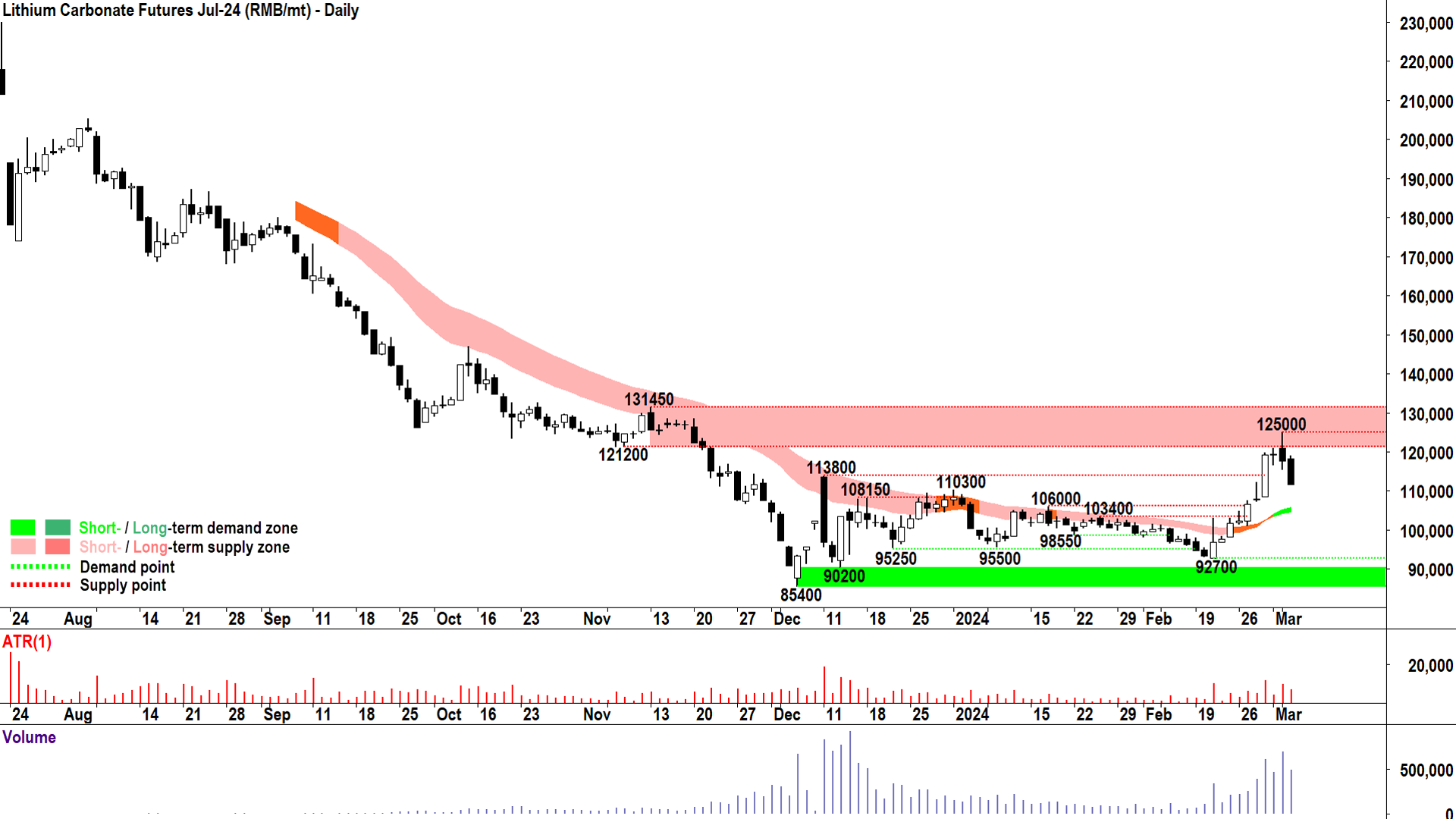Citi and UBS weigh in on lithium rally: Don’t assume low is in yet
News Flash: Lithium prices have turned!
You probably knew this, after all, who hasn’t been following the trials and tribulations in the lithium market lately? And why not, the moves have been breathtaking. Just looking at lithium carbonate futures, we’re talking about a 46% rally since the December low of RMB 85,400 to the RMB 125,000 peak on 4 March.

There’s two big buts here:
Big but 1: Even at the 4 March peak prices were still down around 80% from the all-time highs; and,
Big but 2: The price tanked 5% yesterday so it’s clear that the sellers aren’t completely done just yet (dun-dun-duuuun!)
The boffins at major brokers Citi and UBS have also noticed the fledgling lithium rally, and in separate research notes released this morning, they’ve weighed in on its likely sustainability.
Citi on the lithium rally
Citi says lithium demand growth “remains strong”, but as far as the current rally goes, they’re “waiting on [the] supply response at current prices”. The broker has formed a view that “lithium prices have bottomed near-term and that long-term demand growth rates remain intact”.
The reasons for Citi’s optimism are drawn from a recent chat with consultant Chris Berry of House Mountain Partners. Berry suggests as much as 200kt of lithium carbonate equivalent (LCE) supply is “either not economical or at risk at current prices”.
The pivotal factor determining near-term price action is whether this supply withdraws from the market or continues to commit. Citi agrees with this view but notes there are few other “short term positive catalysts” to support the current rally. Still, they believe prices can “slowly move up towards ~$20k/t” by the end of this year.
US$20,000/t equates approximately RMB 144,000 at the current exchange rate. This is a tidy premium to the current spot lithium carbonate price of RMB 107,500/t. If Citi’s price prediction is correct, lithium bulls could enjoy a solid recovery in ASX lithium stocks this year.
In the longer term, Citi again cites Mr. Berry’s analysis which suggests the lithium price recovery may continue beyond 2024. Here are a few bullets from Citi’s analysis which are likely to have the greatest positive impact the lithium market in the long term:
As more battery capacity comes on stream, battery costs will fall to achieve parity between EVs and internal combustion engine (ICE) vehicles by 2026-27
Lower battery costs will drive greater EV penetration (to 20% in Western markets)
Higher costs of funding and low lithium prices have “begun to take a toll on large market participants” and this will crimp supply in the medium term, Berry forecasts a significant supply deficit (200kt/p.a.) over the next 10 years
Around 200kt of lepidolite supply is at risk at spot prices, and some Australian spodumene producers are also compromised, suggests a price floor around US$20,000/t-US$25,000/t “is needed to incentivize new supply”
Chinese lepidolite is unlikely to flood the market as producers are “not vertically integrated”, would be required to achieve this to operate at current prices
UBS on the lithium rally
UBS is also sounding an optimistic tone on short-term lithium prices. They suggest “more supply has been curtailed, slowed or delayed” since their last update on the lithium market. This has caused the broker to slash their expected 2024 surplus from 142kt to 94kt. To put this into perspective, it’s the difference between 6 weeks of market supply and just 4 weeks.
Reasons for the curtailment include a slowing in Chinese lepidolite supply, environmental inspections in China, delays and production cutbacks at key major producers, and “new projects are being pushed out”.
UBS suggests recent market moves reflect “progress towards rebalancing” but warns “it could be transitory if price sentiment lifts too far too fast”. The broker is concerned market participants will view the recent rally as the much-anticipated restocking rally and overestimate the sustainability of short term demand, when in fact the market remains in surplus.
If market participants choose to restart supply in anticipation of higher prices, UBS is concerned the rally will die out swiftly. “For now, we don’t see enough potential demand growth to absorb possible restarts”, they say. In this scenario, UBS expects “sideways/lower futures prices” until the end of June.
Assuming the supply side can restrain themselves, UBS notes there some restocking is currently underway and this could assist prices to be “well bid in March/April”. But even with supply side restraint, UBS believes “as restocking completes and environmental inspections normalise, we see the current rally fading into mid-year.”
On equities, UBS suggests ASX lithium stocks have “run ahead of fundamentals and are pricing in well above spot/our revised forecasts”. As a result, the broker has cut its rating on IGO (ASX: IGO) from NEUTRAL to SELL (i.e., the same rating they have on Pilbara Minerals (ASX: PLS) and Mineral Resources (ASX: MIN)) and has also cut its rating on Liontown Resources (ASX: LTR) from BUY to NEUTRAL.
Conclusion
Clearly the lithium market is in a far more balanced position than it was before December’s nadir. However, according to our learned friends at Citi and UBS, it remains in a state of substantial flux and there’s great uncertainty as to whether “the low” is in. Lithium investors should be mindful that prices can overshoot to the upside, too.
This article first appeared on Market Index on Wednesday 6 March 2024.
5 topics
4 stocks mentioned

